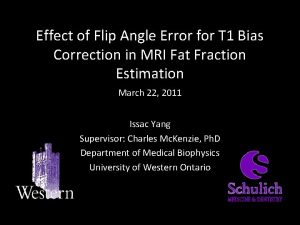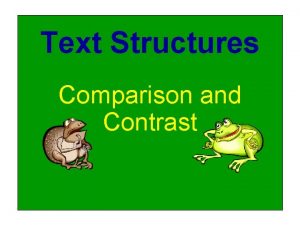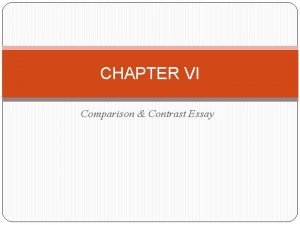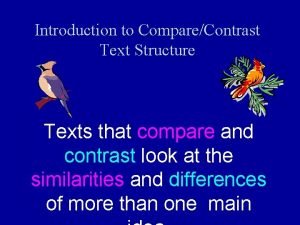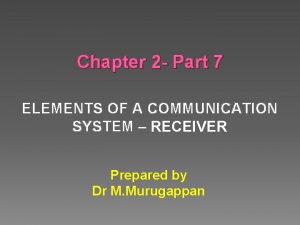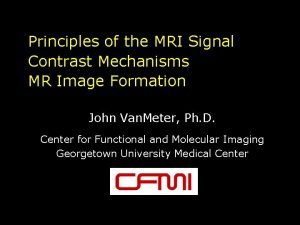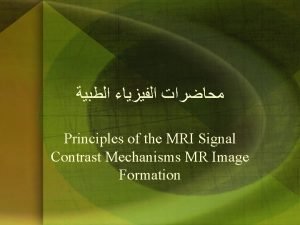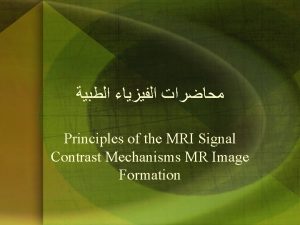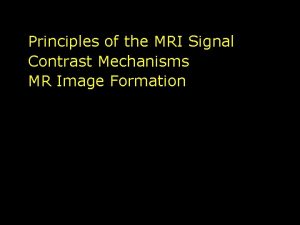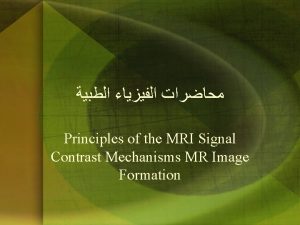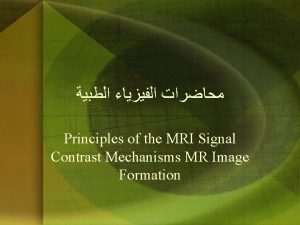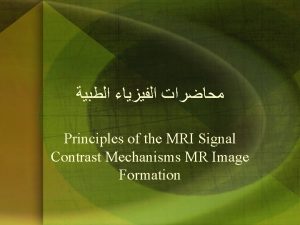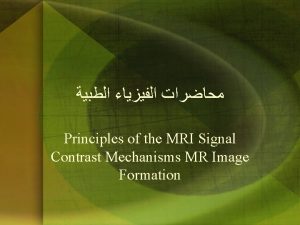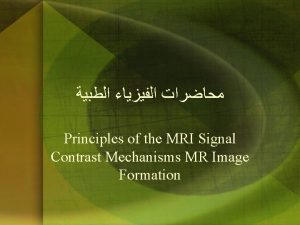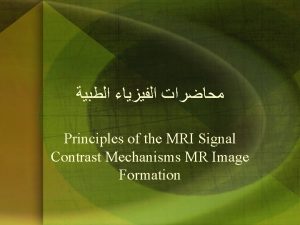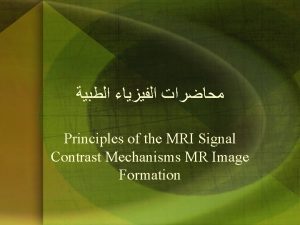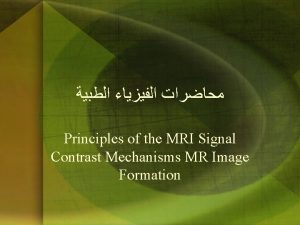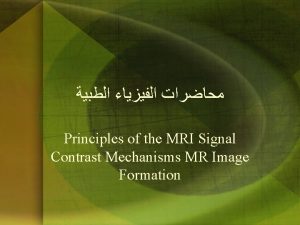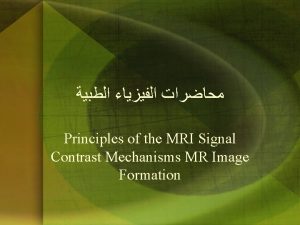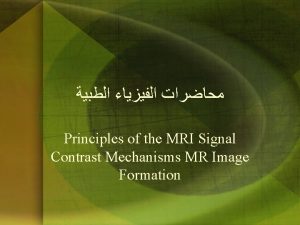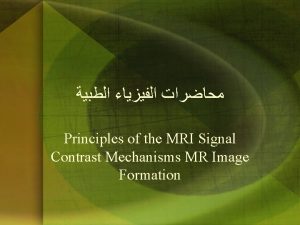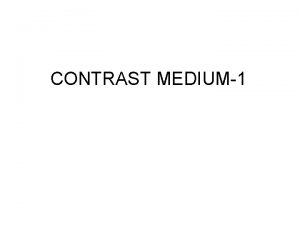Principles of the MRI Signal Contrast Mechanisms MR




















- Slides: 20

ﺍﻟﻄﺒﻴﺔ ﺍﻟﻔﻴﺰﻳﺎﺀ ﻣﺤﺎﺿﺮﺍﺕ Principles of the MRI Signal Contrast Mechanisms MR Image Formation


How do protons interact with a magnetic field? • Moving (spinning) charged particle generates its own little magnetic field – Such particles will tend to line up with external magnetic field lines (think of iron filings around a magnet) • Spinning particles with mass have angular momentum – Angular momentum resists attempts to change the spin orientation (think of a gyroscope)

index Interaction with B 0 1. Orientation :

index Interaction with B 0 2. Energy states : DE = għBo = ħwo

index Interaction with B 0 3. Precession : Rotation or precession about the axis of the magnetic field Bo with frequency : wo = g. Bo wo = Larmor frequency g = gyromagnetic ratio

index Interaction with B 0 3. Precession : At the equilibrium state : - rotation in phase - no transverse magnetization Mxy y x

Effect of Static Field on Protons Bo

index Interaction with B 0 4. Summary : at the equilibrium state : 1. spin orientation « up » > « down » longitudinal magnetization Mz 2. precession no transverse magnetization Mxy

Interaction with B 1 Resonance phenomenon TRANSITIONS Transitions E 1 E 2 Mz decreases REPHASING Phase coherence increases Mxy increases !!! RF frequency = Larmor frequency = w 0 !!!

index Interaction with B 1 From the macroscopic point of view… Two different processes : 1. Transitions E 1 E 2 Mz decreases 2. Rephasing Mxy increases The macroscopic magnetization flips from the z-axis to the xy-plane and precesses

Precession in Magnetic Field

Net magnetization

Net magnetization • Small B 0 produces small net magnetization M • Larger B 0 produces larger net magnetization M, lined up with B 0 • Thermal motions try to randomize alignment of proton magnets • At room temperature, the population ratio of antiparallel versus parallel protons is roughly 100, 000 to 100, 006 per Tesla of B 0

The Zeeman effect n The dependence of electronic transition energies on the presence of a magnetic field reveals electron spin (orbital angular momentum)

Energy Difference Between States

Energy Difference Between States D E = h n D E = 2 mz B o n = g/2 p Bo known as Larmor frequency g/2 p = 42. 57 MHz / Tesla for proton Knowing the energy difference allows us to use electromagnetic waves with appropriate energy level to irradiate the spin system so that some spins at lower energy level can absorb right amount of energy to “flip” to higher energy level.

Basic Quantum Mechanics Theory of MR Spin System Before Irradiation Bo Lower Energy Higher Energy

The Effect of Irradiation to the Spin System Lower Higher

Basic Quantum Mechanics Theory of MR Spin System After Irradiation
 Fat signal mri
Fat signal mri Double contrast vs single contrast
Double contrast vs single contrast Venn diagram of hurricanes and tornadoes
Venn diagram of hurricanes and tornadoes Difference between brownie and cake
Difference between brownie and cake Examples of signal words
Examples of signal words Comparison contrast signals
Comparison contrast signals What does contrast and contradiction mean
What does contrast and contradiction mean Compare and contrast of cardinal and cedar waxwing
Compare and contrast of cardinal and cedar waxwing Baseband signal and bandpass signal
Baseband signal and bandpass signal Baseband signal and bandpass signal
Baseband signal and bandpass signal Digital signal as a composite analog signal
Digital signal as a composite analog signal What is the product of an even signal and odd signal
What is the product of an even signal and odd signal Five design principles
Five design principles Proximity and harmony
Proximity and harmony Basic principles of signal reproduction
Basic principles of signal reproduction Hát kết hợp bộ gõ cơ thể
Hát kết hợp bộ gõ cơ thể Lp html
Lp html Bổ thể
Bổ thể Tỉ lệ cơ thể trẻ em
Tỉ lệ cơ thể trẻ em Voi kéo gỗ như thế nào
Voi kéo gỗ như thế nào Chụp phim tư thế worms-breton
Chụp phim tư thế worms-breton
